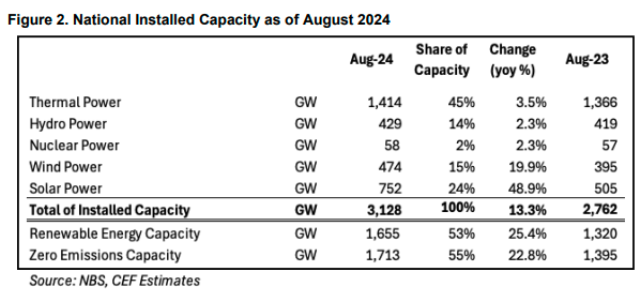Climate Energy Finance reports a remarkable surge in China’s renewable energy capacity during the first eight months of 2024. The country added 210 gigawatts (GW) of new capacity to its grid, marking a 14 percent year-on-year increase. Notably, 25.1 GW of this capacity was added in August alone.
In financial terms, China invested RMB 333 billion (approximately US$47 billion) on power grid projects from January to August, reflecting a 19 percent increase compared to the same period last year. Of this investment, RMB 79 billion (US$11 billion) was allocated in August.
A significant highlight is that 86 percent of the newly added capacity was zero-emissions, demonstrating a 21 percent increase. In August, 83 percent of new capacity additions also fell under the zero-emissions category.
The surge in solar energy capacity remains a dominant trend, with 140 GW added from January to August, accounting for 67 percent of the total newly added capacity, up 24 percent. Specifically, 16.5 GW of solar capacity was added in August. Wind energy saw 33.6 GW of new installations, making up 16 percent of the total additions, also reflecting a 16 percent increase. In August, 3.7 GW of wind capacity was introduced.
Conversely, hydropower capacity saw a decrease, with only 6.6 GW added from January to August, representing 3 percent of total additions and a 9 percent decrease. In August, 700 megawatts (MW) of hydropower was added. The nuclear sector contributed 1.2 GW to the grid, accounting for just 1 percent of total capacity added, with no new installations reported in August.
Thermal power, while still significant, saw a decline, with 28.6 GW added during the first eight months, representing 14 percent of total new capacity — a 17 percent decrease. August alone accounted for an additional 4.2 GW of thermal capacity.
By the end of August 2024, China’s total installed capacity reached 3,128 GW, marking a 13.3 percent increase. Of this, 55 percent (or 1,713 GW) is now from zero-emissions sources, reflecting a 22.8 percent increase. Solar energy leads this growth with 752 GW installed, followed by wind at 474 GW and hydropower at 429 GW.
China’s electricity demand has also risen, increasing 7 percent year-on-year to reach 6,456 terawatt-hours (TWh). This growth highlights the country’s ongoing economic resilience and its commitment to a comprehensive electrification strategy.
Zero-emissions sources contributed 39 percent of total power generation during this period, equating to 2,498 TWh, a 17.4 percent increase. Hydropower was the largest contributor among zero-emissions sources, generating 892 TWh, followed by wind at 655 TWh and solar at 532 TWh, representing 37 percent increase.

